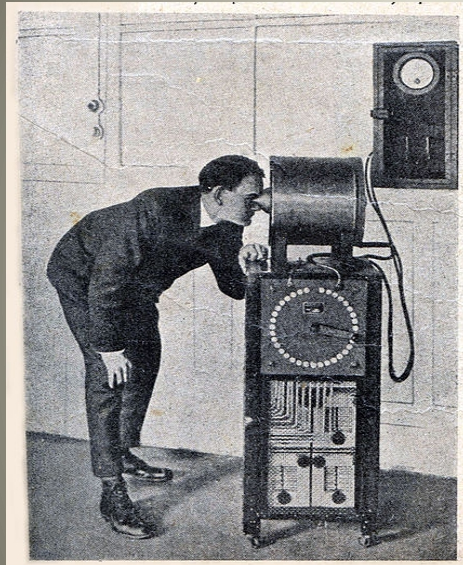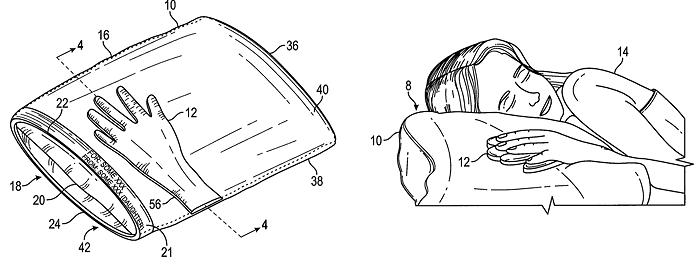Inventions
Mystery Gadget 90
What's this device do?
The answer is here.
Or after the jump.
More in extended >>
Posted By: Paul - Thu Dec 10, 2020 -
Comments (1)
Category: Inventions, Technology, 1910s
Static
A quirky, out-of-place worker (Keith Gordon) at a crucifix factory invents a device he claims can show pictures of Heaven. Discouraged and confused by the inability of those around him to see anything but a screenful of static, he charismatically hijacks a bus of friendly elderly people in order to get media attention for his invention.
The director's page.
Posted By: Paul - Sat Dec 05, 2020 -
Comments (2)
Category: Death, Eccentrics, Crackpots, Inventions, Television, 1980s
Comforting Hand Pillow
Madeline Robertson was recently granted a patent for a pillow with a foam hand sewn onto it. She explains that the hand (or 'tactile object,' as she refers to it) "provides tactile sensory feedback to the user designed to comfort the user."It reminds me of that robotic hand for people who have no one to hold their hand on walks we recently posted about.
Patent No. 10806281: Substrate having a therapeutic tactile object attached

Posted By: Alex - Mon Nov 30, 2020 -
Comments (0)
Category: Inventions, Patents, Sleep and Dreams
The Language of Deseret
I was unaware that Brigham Young created a new alphabet for his followers. "However, the alphabet failed to gain wide acceptance and was not actively promoted after 1869."Here is a page at the official Mormon site that tells of it.

Here is an encyclopedia entry with the full alphabet.
Posted By: Paul - Sun Nov 29, 2020 -
Comments (5)
Category: Eccentrics, Inventions, Languages, Religion, Nineteenth Century
The Night Mayor
Night Mayor, Guy Maddin, provided by the National Film Board of Canada
An explanation.
Posted By: Paul - Wed Nov 25, 2020 -
Comments (2)
Category: Hoaxes and Imposters and Imitators, Inventions, Movies, North America, Twenty-first Century
The feather paintings of Ida Jarvis
Ida Helen Jarvis came up with the idea of making pictures out of feathers. She would travel around the world, visiting zoos and aviaries to add to her feather collection. Then she would arrange the feathers to form pictures of landscapes, gluing or stitching the feathers onto a cardboard mat.She was so taken with this idea that she decided to patent it (Patent No. 1,395,575, 1921). Included in her patent was the idea of using down to represent foam in a stream of water.
Her feather paintings must have been quite colorful. But unfortunately the only image of one I can find is the black-and-white drawing included with her patent.

Posted By: Alex - Sun Nov 22, 2020 -
Comments (3)
Category: Art, Inventions, Patents, 1920s
Beauty Pillow
Patent No. 2,533,526 was granted to Yvonne Bersia Snyder of Forest Hills, NY for a "Beauty Pillow":During sleep the tissues of the face are usually crushed or folded in the same position for hours at a time. For example, the flesh of the cheeks or face when flattened against the pillow during the sleeping hours pushes the skin forwards and settles in the hollows of the eyes where it produces wrinkles.
It is an object of this invention to prevent wrinkles or damaging of the skin tissues during rest.
Looks like it could also double as headgear for full-contact sports.

Posted By: Alex - Sun Nov 15, 2020 -
Comments (3)
Category: Beauty, Ugliness and Other Aesthetic Issues, Inventions, Patents, Sleep and Dreams, 1950s
Sleep Robot
Posted By: Paul - Mon Nov 09, 2020 -
Comments (0)
Category: Anthropomorphism, Inventions, Sleep and Dreams, Europe
Glue-On Sweat Diverter
Rosecroft Components recently (Dec 2019) was granted a patent for a glue-on "sweat diverter". From their patent:Described herein are sweat-diverting devices which may be affixed to a wearer by an adhesive, such as a pressure-sensitive adhesive...
A sweat-diverting device may be reusable, with an adhesive reapplied for each wearing, or may be single use and disposable, with the adhesive integrated with the device during manufacturing.




Posted By: Alex - Sun Oct 25, 2020 -
Comments (1)
Category: Fashion, Headgear, Inventions, Patents, Body Fluids
Wrinkle Mask
Adelaide Smith was granted a patent for this "wrinkle mask" in 1911. It has a certain Bride of Frankenstein look to it.
My invention dispenses with the usual work in massaging, employed for removing the wrinkles or blemishes from the face, and can be used at any time more particularly, however, at nights while the patient is sleeping.
Posted By: Alex - Sun Oct 18, 2020 -
Comments (3)
Category: Beauty, Ugliness and Other Aesthetic Issues, Inventions, Patents, 1910s

| Who We Are |
|---|
| Alex Boese Alex is the creator and curator of the Museum of Hoaxes. He's also the author of various weird, non-fiction, science-themed books such as Elephants on Acid and Psychedelic Apes. Paul Di Filippo Paul has been paid to put weird ideas into fictional form for over thirty years, in his career as a noted science fiction writer. He has recently begun blogging on many curious topics with three fellow writers at The Inferior 4+1. Contact Us |




